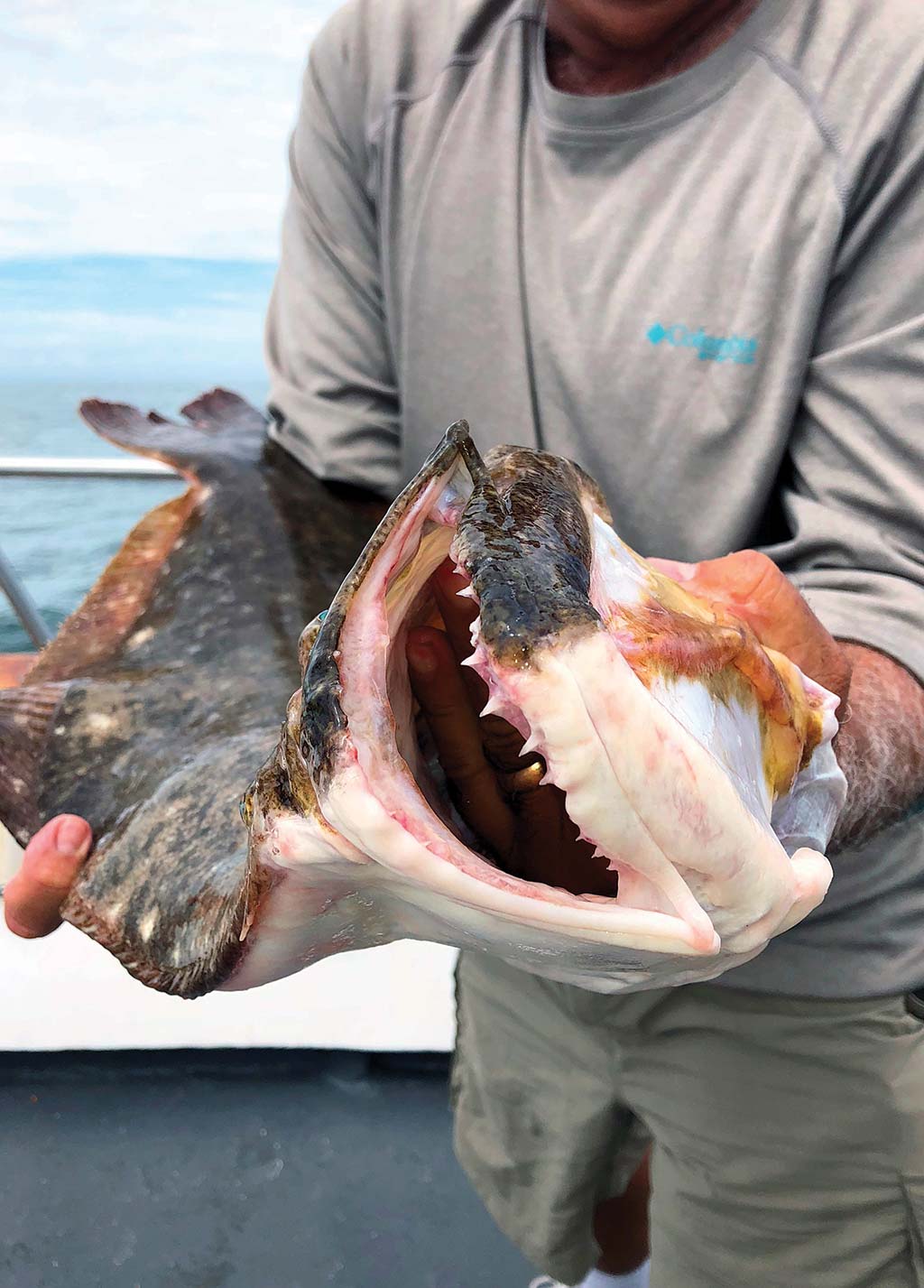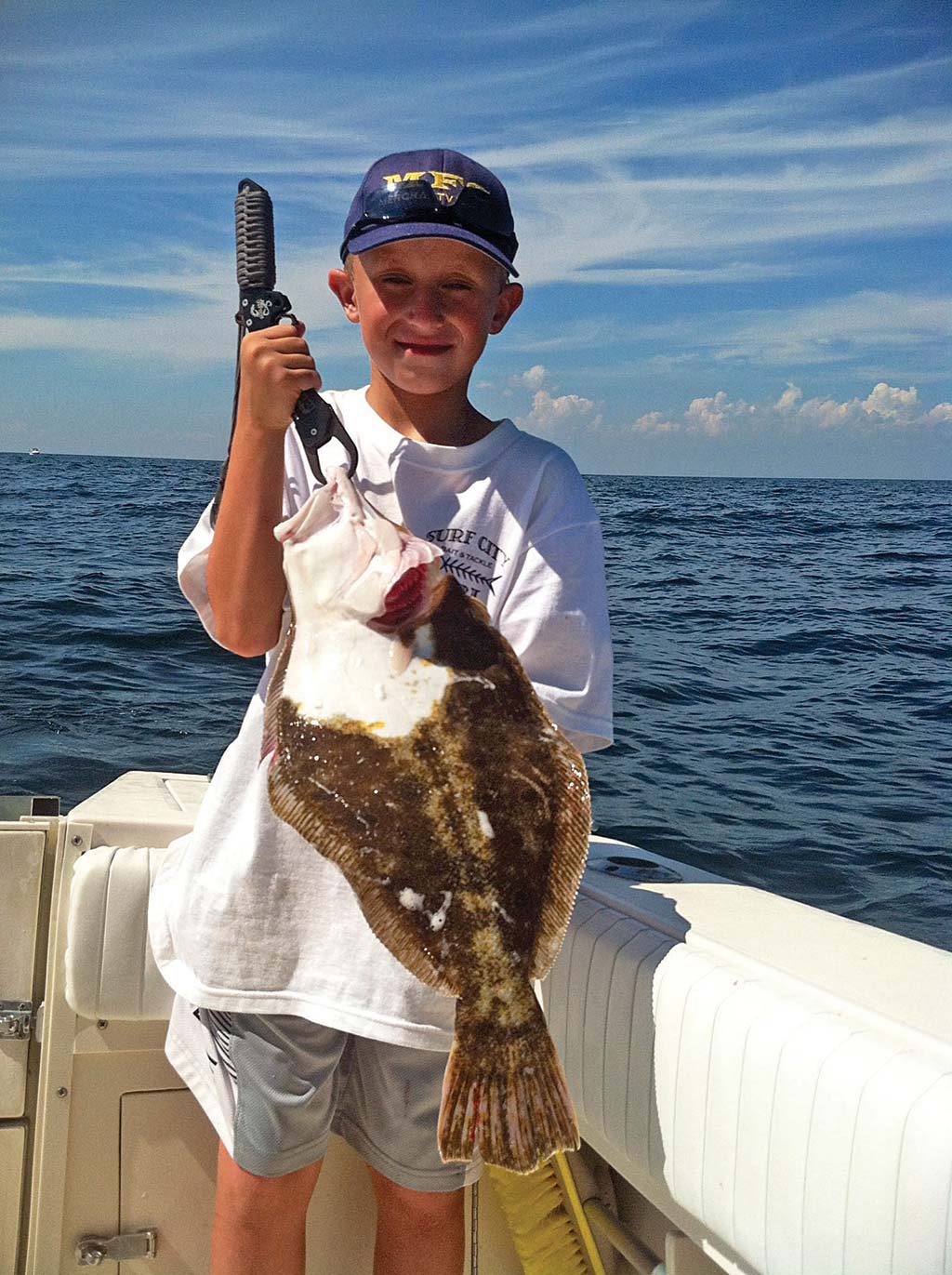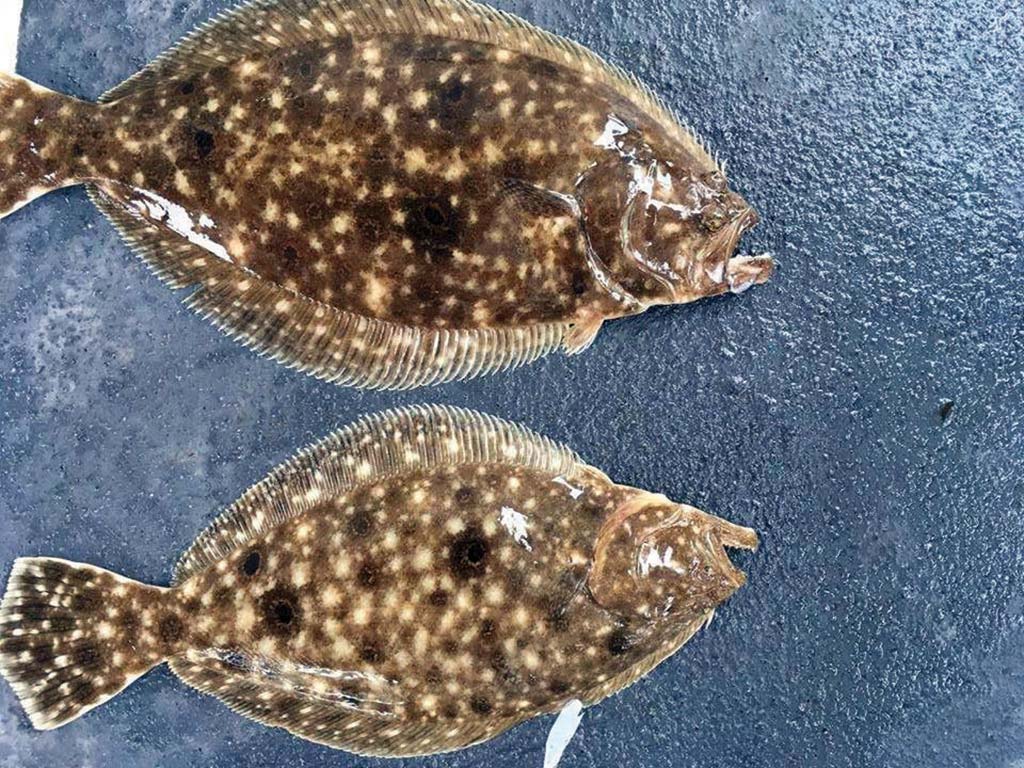
If something just does not look right about that fluke, there’s probably science behind it.
The call came in at about five o’clock from a commercial dragger working along the 10-fathom contour off Point Pleasant who had picked up a flatfish that looked like a winter flounder except, according to the captain, “it’s all turned around.” Could I identify it? I was intrigued. Upon meeting him at the dock and seeing the fish, I was immediately certain of two things – it was indeed a winter flounder but it was backwards, having the eyes on the wrong side of its head!
Many people might not realize that flounder, the summer (fluke) or winter varieties, don’t lie on their bellies but actually lie on their right or left side depending on the species. For example, winter flounder are members of the taxonomic family Pleuronectidae, which includes a variety of flatfish species referred to as righteye flounder because in the wild they lay on the bottom on their left side with their eyes on the right side of their head.
Summer flounder, on the other hand, belong to the taxonomic family Bothidae, which includes species known as lefteye flounder owing to the fact that they lie on their right side and have their eyes on the left side of the head. The side that flatfish lay on is the ‘blind’ side, which is typically completely white. The upper, pigmented side visible as the fish lies on the bottom is referred to as the ‘ocular’ (-eyed) side.
As larvae, flatfish begin life with one eye on each side of their head. They are also pigmented on both sides at this time. Once metamorphosis begins, a unique transformation takes place. The pigment cells on the blind side gradually shrink, collapse, and eventually disappear after undergoing a process known as cytolysis, while adult-like pigment cells continue to form on the ocular side.
In addition, their skulls twist and one of the eyes begins to move to the other side of the head. By the final stage of metamorphosis, this eye has ‘migrated’ completely around the head with the twisting of the skull until both eyes are next to each other on the upper, ocular side of the head. At this point, they have transformed into small juveniles that eventually head to the bottom and begin their demersal lifestyle exhibiting all of the typical flatfish characteristics anglers are familiar with.
Something’s Not Right
But, there are a variety of abnormalities among flatfish that have periodically appeared in scientific journals. While these anomalies don’t seem to impact their normal behavior, they make for some interesting departures from typical flounder characteristics familiar to anglers. These include accounts of the occurrence of a pigmentation abnormality known as ambicoloration and several morphological deformities that include incomplete eye migration to the ocular side, which is typically accompanied by a hook at the forward end of the dorsal fin, and a phenomenon known as ‘sidedness’ or reversal.
In the case of ambicoloration, in addition to having normal dark pigmentation on the upper, ocular side – rather than being completely white – the blind side also exhibits coloration that closely resembles the ocular side. In most of these cases, there is apparently nothing on the upper surface of an ambicolorate flatfish to indicate that the fish is abnormal on the other side.
Various degrees of ambicoloration actually exist. Partial ambicoloration is some areas of blind side skin showing dark side pigmentation. This may include irregular patches of pigment on the blind side that are lighter than the pigmentation on the eyed side and the presence of black or brown spots occupying similar positions as the dark spots on the ocular side. There could also be dark areas of pigment covering most of the blind side, with the exception of the head and a portion of the area behind the head that remains white.
With complete ambicoloration, the blind side pigmentation mimics the normal pigment pattern on the ocular side so that the blind side has almost no white skin on it at all. When completely ambicolored flounder are encountered, they are often referred to as having ‘black belly’. It is interesting to note that incomplete eye migration to the ocular side and the presence of a hook at the front end of the dorsal fin frequently accompanies complete ambicoloration, something not typically seen in partially ambicolored individuals.
At some point during their development prior to metamorphosis a distinction between which side is the left side and which side is the right side of a flatfish occurs. How exactly this happens, is one of evolution’s many mysteries. And, although this ‘sidedness’ is normally consistent within a species, at times the pattern apparently can somehow become transposed resulting in a wrong-sided, or reversed flatfish
For example, the winter flounder the dragger captain called me about had its eyes on the left side although typically eyes on the right side is the rule for this species, so this particular individual was reversed.

A History Of Anomalies
Reports of ambicoloration and reversal in flatfish date back to observations made by naturalists and ichthyologists in the 1800’s and early 1900’s. For example, in his 1815 article on the Fishes of New York, American naturalist Samuel L. Mitchell reported that he had collected a black-bellied flounder described as having a “belly almost as dark colored as the back whose eye was barely over the ridge of the dorsal fin, which was hooked in the front”. In A History of the Fishes of Massachusetts published in 1861, another American naturalist, David H. Storer, described having collected an ambicolored southern flounder with an incompletely rotated eye and a hooked dorsal fin and a four-spot flounder with dark color on both sides. During the winter of 1898 and 1899 while serving as director of the US Fish Commissions biological laboratory at Woods Hole in Massachusetts, Hermon C. Bumpus reported that he collected a great number of ‘black-bellied’ winter flounder in Greenwich Bay, RI.
Perhaps the most renowned authority when it comes to abnormalities in flatfish was ichthyologist E.W. Gudger, who served as Curator of Fishes at the American Museum of Natural History throughout the 1930s. From the docks and wharves of New England and the Mid-Atlantic to the fish markets of Boston, New York and points south, if an anomalous flatfish was landed, it seems like Gudger was there to record, describe, and document the occurrence.
Gudger was so prolific in searching out and documenting the occurrence of flounder with abnormalities that he published over a dozen articles based on his collections and observations. Among his reports are numerous accounts of partial or complete ambicoloration and reversal in species familiar to anglers including winter flounder, summer flounder, and southern flounder as well as some perhaps lesser known, but commonly occurring species including yellowtail flounder and four-spot flounder. In addition to papers on individual fish, in 1936 he published a comprehensive synopsis of records of flatfish anomalies from around the world in order to, in his words, “consider the whole question of abnormalities in flatfishes as found in the scientific literature is vast, incoherent, unclassified and undigested.”
Not Just Flounder
Gudger once noted that while reading the NY Times one morning in February 1935 he came across an account of an all-black Atlantic halibut being displayed at the Boston Fish Pier, the first of its kind he had ever heard of. He apparently dropped everything and headed to Boston to collect it. Not surprisingly, he eventually collected and described other ambicolored halibut, including individuals that had hooked dorsal fins and partially rotated eyes, as well as another that was reversed in addition to being ambicolored, which he considered an unusual combination.
Gudger was the first scientist to systematically document the frequency of the association of incomplete or partial rotation of the eye to the ocular side and the presence of a hooked forward end of the dorsal fin as being a somewhat common occurrence in flounder exhibiting total ambicoloration. According to Gudger’s analysis, whenever the entire lower surface of the blind side is colored like the ocular side, or when most of the head region on the blind side is colored, the rotating eye will not completely migrate past the crest of the dorsal fin and the forward end of the dorsal fin will become hooked. This subsequently became dubbed as the ‘Gudger Rule’ among ichthyologists reporting on flatfish anomalies after Gudger’s time as it apparently was accurate in terms of the circumstances surrounding the occurrence of this combination of abnormalities.
In fact, in an article published in 1962, C.E. Dawson, Senior Ichthyologist at the Gulf Coast Research Lab in Ocean Springs, MS stated “to this writer’s knowledge, no specimens found during the past 24 years have violated this statement.”
During the 1960s, as he was cataloging fishery resources of the eastern Gulf of Mexico, Dawson also described a number of ambicolored flatfish he had collected from local Gulf waters or received from anglers along the Gulf and Atlantic coasts including ambicoloration in southern flounders, hogchokers and blackcheek tonguefish. Taking a cue from Gudger, Dawson apparently became somewhat of a new keeper of records of the occurrence of anomalies in flatfishes because of what he called “a revived interest in abnormalities in American flatfishes” eventually publishing an updated synopsis of known anomalous flatfish from U.S. coastal waters. In that manuscript, Dawson made note of the fact that, based on his extensive review “it seems evident that abnormal flatfish occur most frequently along the eastern seaboard north to Nova Scotia.”
Since Dawson’s time, records of ambicoloration and morphological abnormalities in many species of flatfish from U.S. coastal waters periodically appear in the scientific literature. These include additional records of ambicoloration and reversal in the Atlantic halibut, winter flounder, summer flounder, southern flounder, hogchokers, and blackcheek tonguefish as well as new records for ambicolored tonguefish, Gulf flounder, American plaice, witch flounder and ambicoloration and reversal in fringed flounder.

But Why?
Globally more than 570 species of fish are recognized as flatfishes, all grouped together by scientists in the taxonomic order Pleuronectiformes. And, while a review of published accounts of abnormalities in flatfish might lead you to conclude that they are more prevalent in lefteyed and righteyed flounder, the infrequency of reported anomalies in sole, turbots and tonguefish may simply be related to the lack of commercial or recreational fishing effort on these families.
In any event, regardless of the species, the specific causes of ambicoloration or morphological deformities in wild stocks of flatfish remain unclear. However, there seems to be agreement among experts that based on observations in the wild, as well as information from lab experiments and flounder rearing facilities, it appears likely that these anomalies probably result from mutations or from external environmental influences that happen during the larval stage prior to and during metamorphosis.
Interestingly, most reports of ambicoloration involve species from cooler coastal climates whose distributions are generally confined to shallow coastal waters and estuaries where the greatest variations in environmental conditions occur. Therefore, it is likely that in some years suboptimal conditions may be encountered during and after spawning which could affect egg quality, hatching, or larval development and metamorphosis.
Among the most important factors identified as possible triggers of both pigmentation and morphological abnormalities are exposure to elevated light intensity on that side of during larval development and temperature extremes, especially unusually low temperatures during larval development and metamorphosis that likely disrupt normal developmental mechanisms.
Diet during larval development, especially at the beginning of metamorphosis, can also potentially affect the development of normal pigmentation in fish. The period of time when diet influences the development of pigmentation in fish is short. Since flatfish larvae begin to feed primarily on zooplankton a few days after hatching, if they encounter a lack of availability of suitable prey or if the available prey provides them with a suboptimal diet, the resultant nutritional deficiencies that would occur have also been noted to potentially play a role in flounder becoming ambicolored.
As for the phenomenon of reversal, the evolutionary basis and mechanism that establishes the orientation or ‘sidedness’ in terms of which side is the blind side and which is the ocular side in flounder and other flatfish is not known. However, a number of researchers have speculated that the reversal syndrome likely has a strong genetic component.
Catch an odd fluke? How about flounder? Email us at [email protected].




